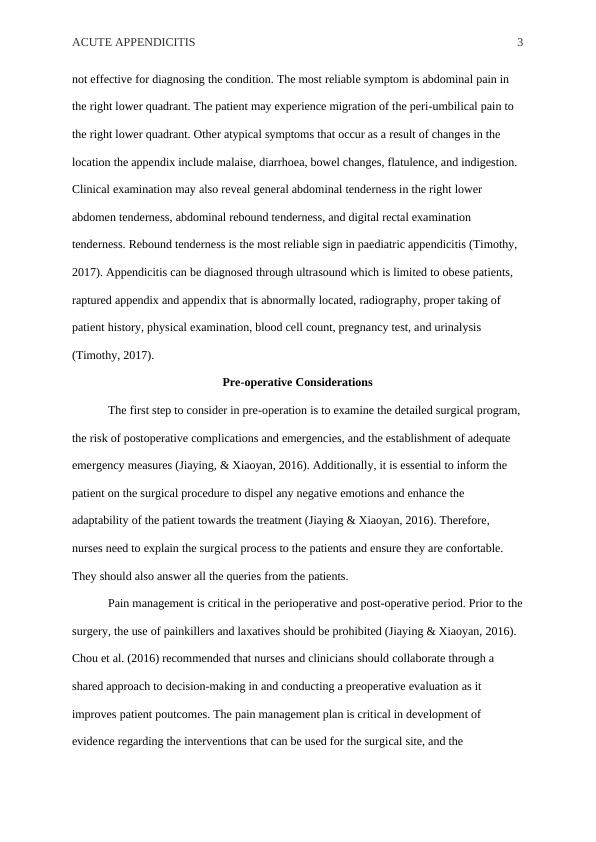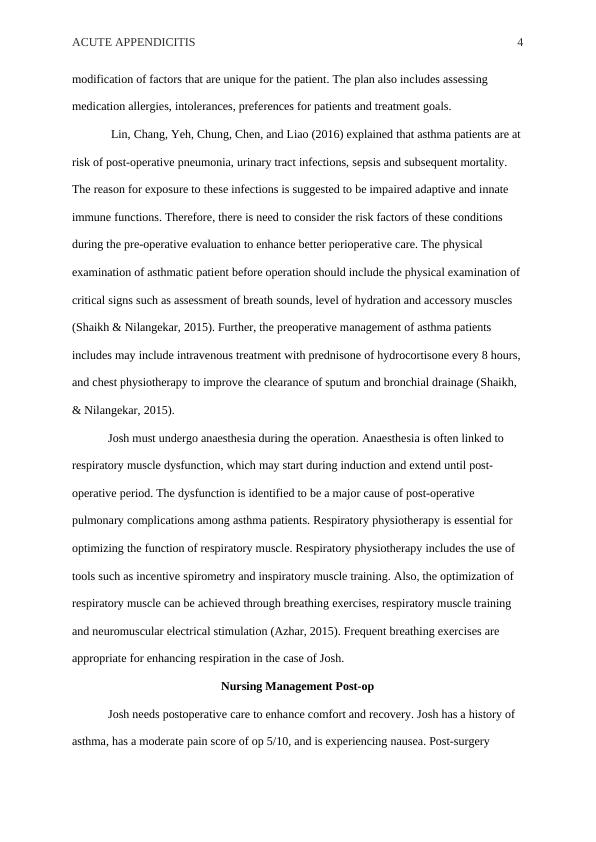Acute Appendicitis Assessment 2022
Produce an assignment on a patient with appendicitis and the nursing care required, including pathophysiology, clinical manifestations, pre-operative considerations, nursing diagnosis, SMART goals, and implementation.
13 Pages3487 Words33 Views
Added on 2022-10-04
Acute Appendicitis Assessment 2022
Produce an assignment on a patient with appendicitis and the nursing care required, including pathophysiology, clinical manifestations, pre-operative considerations, nursing diagnosis, SMART goals, and implementation.
Added on 2022-10-04
ShareRelated Documents
Running head: ACUTE APPENDICITIS 1
Assessment 2: Case study essay
Name
Institutional Affiliation
Assessment 2: Case study essay
Name
Institutional Affiliation

ACUTE APPENDICITIS 2
Introduction
The aim of this paper is to explain the nursing management of Josh, a 29 year old
man, with a history of asthma and has been admitted for acute appendicitis. The paper
explains the management of the patient. The focus of the paper is to utilize evidence-based
information to develop clinical decisions in management of appendicitis among patients with
asthma.
Pathophysiology
There lacks clarity on the exact mechanism of acute appendicitis (Hori et al., 2017).
There are three identified causes of acute appendicitis which include genetic factors,
environmental factors and gastrointestinal infections (Bhangu, Søreide, Di Saverio,
Assarsson, & Drake, 2015). The primary cause of acute appendicitis results from malfunction
in the gastrointestinal system. Luminal obstruction is the primary factor that triggers acute
appendicitis (Petroianu, & Barroso, 2016). The luminal obstruction, which may either be
internal or external, plays a critical role in the pathophysiology of appendicitis. External
luminal obstruction refers to lymphoid hyperplasia while internal luminal obstruction refers
to appendicoliths and inspissated faecal material. The outcome of these factors is stasis, viral
infection, overgrowth of bacteria and mucus production, which results in increased tension of
the appendicular wall. Consequently, the flow of lymph and blood is diminished, followed by
perforation and necrosis. Acute appendicitis develops in an irreversible manner once it is
triggered. After the perforation of the walled-off appendix, an appendicular mass or tumour
developed. The tumour may be an abscess or phlegon (Hori et al., 2017). There are various
symptoms of appendicitis.
Clinical Manifestations of Appendicitis
The most common symptoms of acute appendicitis include abdominal pain, nausea
and vomiting, and anorexia. However, these factors are not specific to appendicitis and are
Introduction
The aim of this paper is to explain the nursing management of Josh, a 29 year old
man, with a history of asthma and has been admitted for acute appendicitis. The paper
explains the management of the patient. The focus of the paper is to utilize evidence-based
information to develop clinical decisions in management of appendicitis among patients with
asthma.
Pathophysiology
There lacks clarity on the exact mechanism of acute appendicitis (Hori et al., 2017).
There are three identified causes of acute appendicitis which include genetic factors,
environmental factors and gastrointestinal infections (Bhangu, Søreide, Di Saverio,
Assarsson, & Drake, 2015). The primary cause of acute appendicitis results from malfunction
in the gastrointestinal system. Luminal obstruction is the primary factor that triggers acute
appendicitis (Petroianu, & Barroso, 2016). The luminal obstruction, which may either be
internal or external, plays a critical role in the pathophysiology of appendicitis. External
luminal obstruction refers to lymphoid hyperplasia while internal luminal obstruction refers
to appendicoliths and inspissated faecal material. The outcome of these factors is stasis, viral
infection, overgrowth of bacteria and mucus production, which results in increased tension of
the appendicular wall. Consequently, the flow of lymph and blood is diminished, followed by
perforation and necrosis. Acute appendicitis develops in an irreversible manner once it is
triggered. After the perforation of the walled-off appendix, an appendicular mass or tumour
developed. The tumour may be an abscess or phlegon (Hori et al., 2017). There are various
symptoms of appendicitis.
Clinical Manifestations of Appendicitis
The most common symptoms of acute appendicitis include abdominal pain, nausea
and vomiting, and anorexia. However, these factors are not specific to appendicitis and are

ACUTE APPENDICITIS 3
not effective for diagnosing the condition. The most reliable symptom is abdominal pain in
the right lower quadrant. The patient may experience migration of the peri-umbilical pain to
the right lower quadrant. Other atypical symptoms that occur as a result of changes in the
location the appendix include malaise, diarrhoea, bowel changes, flatulence, and indigestion.
Clinical examination may also reveal general abdominal tenderness in the right lower
abdomen tenderness, abdominal rebound tenderness, and digital rectal examination
tenderness. Rebound tenderness is the most reliable sign in paediatric appendicitis (Timothy,
2017). Appendicitis can be diagnosed through ultrasound which is limited to obese patients,
raptured appendix and appendix that is abnormally located, radiography, proper taking of
patient history, physical examination, blood cell count, pregnancy test, and urinalysis
(Timothy, 2017).
Pre-operative Considerations
The first step to consider in pre-operation is to examine the detailed surgical program,
the risk of postoperative complications and emergencies, and the establishment of adequate
emergency measures (Jiaying, & Xiaoyan, 2016). Additionally, it is essential to inform the
patient on the surgical procedure to dispel any negative emotions and enhance the
adaptability of the patient towards the treatment (Jiaying & Xiaoyan, 2016). Therefore,
nurses need to explain the surgical process to the patients and ensure they are confortable.
They should also answer all the queries from the patients.
Pain management is critical in the perioperative and post-operative period. Prior to the
surgery, the use of painkillers and laxatives should be prohibited (Jiaying & Xiaoyan, 2016).
Chou et al. (2016) recommended that nurses and clinicians should collaborate through a
shared approach to decision-making in and conducting a preoperative evaluation as it
improves patient poutcomes. The pain management plan is critical in development of
evidence regarding the interventions that can be used for the surgical site, and the
not effective for diagnosing the condition. The most reliable symptom is abdominal pain in
the right lower quadrant. The patient may experience migration of the peri-umbilical pain to
the right lower quadrant. Other atypical symptoms that occur as a result of changes in the
location the appendix include malaise, diarrhoea, bowel changes, flatulence, and indigestion.
Clinical examination may also reveal general abdominal tenderness in the right lower
abdomen tenderness, abdominal rebound tenderness, and digital rectal examination
tenderness. Rebound tenderness is the most reliable sign in paediatric appendicitis (Timothy,
2017). Appendicitis can be diagnosed through ultrasound which is limited to obese patients,
raptured appendix and appendix that is abnormally located, radiography, proper taking of
patient history, physical examination, blood cell count, pregnancy test, and urinalysis
(Timothy, 2017).
Pre-operative Considerations
The first step to consider in pre-operation is to examine the detailed surgical program,
the risk of postoperative complications and emergencies, and the establishment of adequate
emergency measures (Jiaying, & Xiaoyan, 2016). Additionally, it is essential to inform the
patient on the surgical procedure to dispel any negative emotions and enhance the
adaptability of the patient towards the treatment (Jiaying & Xiaoyan, 2016). Therefore,
nurses need to explain the surgical process to the patients and ensure they are confortable.
They should also answer all the queries from the patients.
Pain management is critical in the perioperative and post-operative period. Prior to the
surgery, the use of painkillers and laxatives should be prohibited (Jiaying & Xiaoyan, 2016).
Chou et al. (2016) recommended that nurses and clinicians should collaborate through a
shared approach to decision-making in and conducting a preoperative evaluation as it
improves patient poutcomes. The pain management plan is critical in development of
evidence regarding the interventions that can be used for the surgical site, and the

ACUTE APPENDICITIS 4
modification of factors that are unique for the patient. The plan also includes assessing
medication allergies, intolerances, preferences for patients and treatment goals.
Lin, Chang, Yeh, Chung, Chen, and Liao (2016) explained that asthma patients are at
risk of post-operative pneumonia, urinary tract infections, sepsis and subsequent mortality.
The reason for exposure to these infections is suggested to be impaired adaptive and innate
immune functions. Therefore, there is need to consider the risk factors of these conditions
during the pre-operative evaluation to enhance better perioperative care. The physical
examination of asthmatic patient before operation should include the physical examination of
critical signs such as assessment of breath sounds, level of hydration and accessory muscles
(Shaikh & Nilangekar, 2015). Further, the preoperative management of asthma patients
includes may include intravenous treatment with prednisone of hydrocortisone every 8 hours,
and chest physiotherapy to improve the clearance of sputum and bronchial drainage (Shaikh,
& Nilangekar, 2015).
Josh must undergo anaesthesia during the operation. Anaesthesia is often linked to
respiratory muscle dysfunction, which may start during induction and extend until post-
operative period. The dysfunction is identified to be a major cause of post-operative
pulmonary complications among asthma patients. Respiratory physiotherapy is essential for
optimizing the function of respiratory muscle. Respiratory physiotherapy includes the use of
tools such as incentive spirometry and inspiratory muscle training. Also, the optimization of
respiratory muscle can be achieved through breathing exercises, respiratory muscle training
and neuromuscular electrical stimulation (Azhar, 2015). Frequent breathing exercises are
appropriate for enhancing respiration in the case of Josh.
Nursing Management Post-op
Josh needs postoperative care to enhance comfort and recovery. Josh has a history of
asthma, has a moderate pain score of op 5/10, and is experiencing nausea. Post-surgery
modification of factors that are unique for the patient. The plan also includes assessing
medication allergies, intolerances, preferences for patients and treatment goals.
Lin, Chang, Yeh, Chung, Chen, and Liao (2016) explained that asthma patients are at
risk of post-operative pneumonia, urinary tract infections, sepsis and subsequent mortality.
The reason for exposure to these infections is suggested to be impaired adaptive and innate
immune functions. Therefore, there is need to consider the risk factors of these conditions
during the pre-operative evaluation to enhance better perioperative care. The physical
examination of asthmatic patient before operation should include the physical examination of
critical signs such as assessment of breath sounds, level of hydration and accessory muscles
(Shaikh & Nilangekar, 2015). Further, the preoperative management of asthma patients
includes may include intravenous treatment with prednisone of hydrocortisone every 8 hours,
and chest physiotherapy to improve the clearance of sputum and bronchial drainage (Shaikh,
& Nilangekar, 2015).
Josh must undergo anaesthesia during the operation. Anaesthesia is often linked to
respiratory muscle dysfunction, which may start during induction and extend until post-
operative period. The dysfunction is identified to be a major cause of post-operative
pulmonary complications among asthma patients. Respiratory physiotherapy is essential for
optimizing the function of respiratory muscle. Respiratory physiotherapy includes the use of
tools such as incentive spirometry and inspiratory muscle training. Also, the optimization of
respiratory muscle can be achieved through breathing exercises, respiratory muscle training
and neuromuscular electrical stimulation (Azhar, 2015). Frequent breathing exercises are
appropriate for enhancing respiration in the case of Josh.
Nursing Management Post-op
Josh needs postoperative care to enhance comfort and recovery. Josh has a history of
asthma, has a moderate pain score of op 5/10, and is experiencing nausea. Post-surgery

End of preview
Want to access all the pages? Upload your documents or become a member.
Related Documents
Assignment on Case Study of Annelg...
|11
|2579
|65
Nursing Assignment: Pathophysiology Case Studylg...
|7
|2578
|98
Essay On Pathophysiology | Case Study Of Annelg...
|9
|2410
|206
Appendix Assignment 2022lg...
|14
|3224
|15
Child, Adolescent and Family Nursinglg...
|10
|2797
|131
Appendicitis and Peritonitis: Nursing Interventions for Child Patientlg...
|10
|2853
|333
